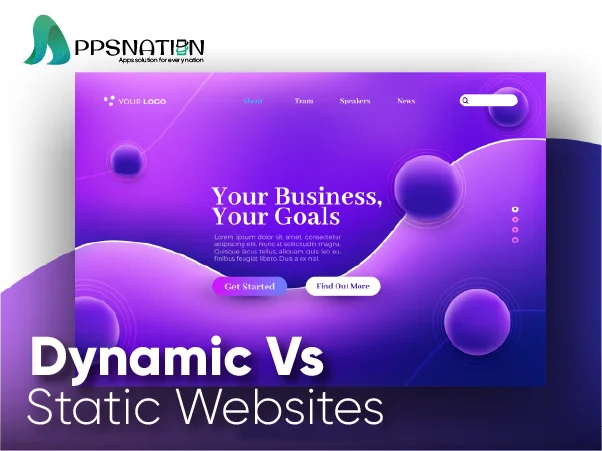Static and dynamic websites are two distinct approaches to web development, each with its own set of advantages and considerations. Understanding the differences between these two types of websites can help you make informed decisions when building or updating your online presence. In this article, we will delve into the intricacies of static and dynamic websites, exploring their characteristics, benefits, and use cases. By the end, you’ll have a comprehensive understanding of the web power unleashed by these two approaches.
Table of Contents
| 1 | Introduction |
| 2 | Static Websites
|
| 3 | Dynamic Websites
|
| 4 | Key Differences between Static and Dynamic Websites
|
| 5 | Choosing the Right Approach for Your Website
|
| 6 | Conclusion |
| 7 | FAQs |
Introduction:
When it comes to creating a website, there are primarily two approaches: static and dynamic. These approaches determine how the web pages are generated and served to the users. A static website consists of HTML and CSS files that are pre-designed and stored on the server, delivering the same content to all users. On the other hand, a dynamic website generates pages on-the-fly by using server-side scripts and a database to deliver personalised content and enable user interaction.
Static Websites
Definition and Features:
Static websites are composed of fixed files that are delivered as-is to the user’s web browser. These websites are primarily built using HTML, CSS, and sometimes JavaScript. Each page on a static website is a separate HTML file, and the content remains the same unless manually updated. Changes to the website usually require editing the HTML files directly.
Advantages:
Static websites offer several advantages, including:
Speed: Since the content is pre-generated, static websites are fast to load and render.
Security: With fewer moving parts and no server-side scripting, static websites are less vulnerable to certain types of attacks.
Simplicity: Building and maintaining static websites is relatively straightforward, making them an ideal choice for smaller projects or simple web pages.
Reliability: Static websites are highly reliable since they don’t rely on complex server-side components.
Limitations:
While static websites have their merits, they also come with some limitations:
Limited Interactivity: Static websites lack dynamic elements and user interactivity beyond basic navigation.
Content Management: Updating content on static websites requires manual editing of HTML files, making it less efficient for frequent updates or large websites.
Scalability: As the website grows in size, managing individual HTML files becomes cumbersome and time-consuming.
Use Cases:
While static websites have their merits, they also come with some limitations:
Brochure Websites: Simple websites that showcase information about a business or organisation.
Landing Pages: Single-page websites designed for marketing campaigns or product launches.
Documentation Sites: Websites that provide static documentation or knowledge bases.
Dynamic Websites
Definition and Features:
Dynamic websites utilise server-side scripts, databases, and other technologies to generate web pages on-the-fly. These websites can deliver personalised content, interact with users, and provide dynamic functionality. Common server-side languages for dynamic websites include PHP, Python, and Ruby, among others.
Advantages
Dynamic websites offer several advantages, including:
Interactivity: Dynamic websites can provide user interactivity, such as user accounts, comments, and personalised content.
Content Management Systems: Dynamic websites often employ content management systems (CMS) that facilitate easy content updates and organisation.
Scalability: With dynamic generation of web pages, dynamic websites can handle a large amount of content more efficiently.
Limitations:
While static websites have their merits, they also come with some limitations:
Performance: Dynamic websites may require more server resources and processing time, leading to slower page load times compared to static websites.
Security Considerations: The dynamic nature of these websites introduces potential vulnerabilities if not properly secured.
Development Complexity: Building dynamic websites requires expertise in server-side scripting languages and databases.
Use Cases:
Dynamic websites find applications in various scenarios, including:
E-commerce Platforms: Websites that support online shopping, product listings, and secure payment processing.
Social Networking Sites: Platforms that enable users to create profiles, connect with others, and share content.
Blogs and News Websites: Websites that deliver timely and frequently updated content to users.
Key Differences between Static and Dynamic Websites
Content Management:
Static websites require manual editing of HTML files to update content, while dynamic websites often employ content management systems (CMS) that simplify content management. With a CMS, non-technical users can easily update content through a user-friendly interface.
Personalization and User Interaction:
Static websites deliver the same content to all users, whereas dynamic websites can personalise content based on user preferences, behaviour, or account information. Dynamic websites can also facilitate user interaction through forms, comments, and user-generated content.
Factors to Consider:
Website Purpose: Determine the primary goals and functionality your website needs to achieve.
Content Updates: Assess the frequency and scale of content updates you anticipate.
Interactivity Requirements: Evaluate whether user interaction and personalised content are essential for your website.
Technical Expertise: Consider the resources and skills available to build and maintain the website.
Decision Guidelines
Choose a static website if you have a small-scale project, limited budget, or need a simple online presence.
Opt for a dynamic website if you require interactivity, personalised content, frequent updates, or more extensive functionality.
Conclusion
In conclusion, both static and dynamic websites have their unique strengths and considerations. Static websites excel in simplicity, speed, and security, while dynamic websites offer interactivity, personalization, and scalability. Choosing the right approach for your website depends on your specific requirements, resources, and technical expertise. By understanding the differences and considering the factors outlined in this article, you can make an informed decision that best aligns with your goals.
FAQ
Q: Can I convert a static website into a dynamic website?
Yes, it is possible to convert a static website into a dynamic website. However, it requires significant modifications to the existing codebase and may involve implementing server-side scripting, database integration, and other dynamic functionalities. It’s advisable to consult with a web developer or utilise a content management system (CMS) to simplify the process.
Q: Which type of website is better for SEO?
Both static and dynamic websites can be optimised for search engines. Both static websites and dynamic websites have the potential to be optimised for search engines. The key factor for SEO success is the quality and relevance of the content, as well as the implementation of SEO best practices, such as optimising page titles, meta tags, URLs, and using proper heading tags. With dynamic websites, it’s crucial to ensure that dynamic content is easily accessible and crawlable by search engine bots.
Q: Are dynamic websites more expensive to build and maintain?
Dynamic websites generally require more initial investment and ongoing maintenance compared to static websites. Building a dynamic website involves additional development complexity, potentially requiring expertise in server-side scripting, databases, and security measures. Moreover, dynamic websites may require regular updates, security patches, and monitoring. However, the added costs can be justified by the enhanced functionality and interactivity dynamic websites provide.
Q: Can a static website be as visually appealing as a dynamic website?
Yes, static websites can be visually appealing and provide an engaging user experience. While dynamic websites offer more interactive and dynamic elements, static websites can still incorporate visually appealing designs, animations, and multimedia elements using HTML, CSS, and JavaScript. The key is to focus on creative and aesthetically pleasing web design principles, regardless of the website type.
Q: What if I need both static and dynamic elements on my website?
It is possible to combine static and dynamic elements on a website to leverage the advantages of both approaches. This can be achieved by using server-side scripting to generate specific sections of a web page dynamically while keeping other parts static. This hybrid approach allows you to have personalised and interactive components while maintaining the efficiency and simplicity of static pages.





